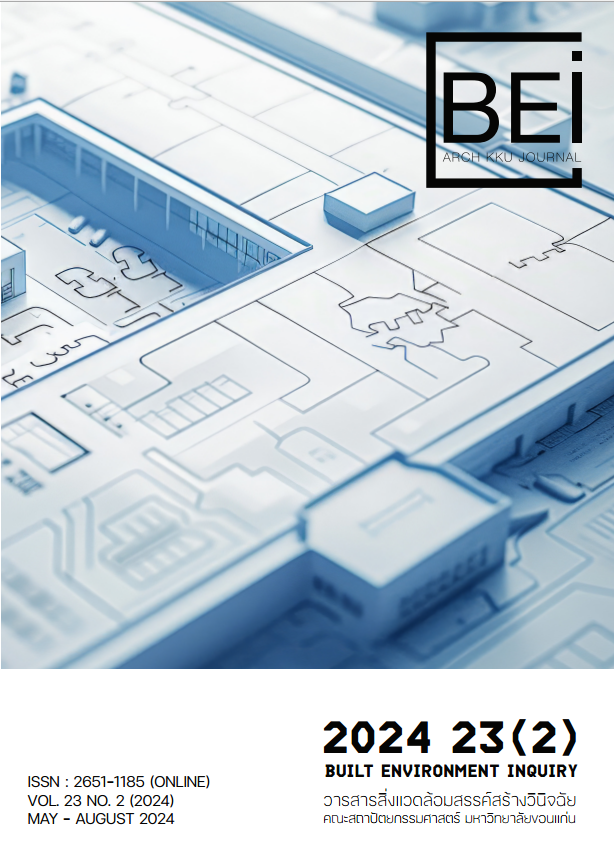External Space Coordinating with Everyday Activities Khlong Toei, Neighborhood Cluster of Low-income Communities as a Case Study
DOI:
https://doi.org/10.14456/bei.2024.11คำสำคัญ:
Low-income community, Everyday activity, External space, Socio-physical environment, Neighborhood clusterบทคัดย่อ
Policies and studies that have been conducted in the past targeting low-income
communities have not fit into the lives of the residents. It is necessary to learn what kind of
living environments have been formed in long-lasting communities. The question of this
study is: How are the living environments formed in accordance with everyday activities?
This study employs qualitative research such as participatory observation combined with
measurement, interviews, and photography. The following three points were clarified by the
investigation. First of all, the residential environment which can be said to be a neighborhood
cluster composed of alley shape, social relationships were clarified. The second point is the
two types of housing frontages. Due to the differences in the physical and social environments,
we found that the activities observed there also differed. The third point is the factor that
formed such living environments. In addition to the original shape of the land, residents
themselves expanded their dwellings or utilized the existing living environment, depending
on their daily needs. This results in a living environment suitable for everyday activities.
เอกสารอ้างอิง
Askew, M. (2002). Bangkok: Place, practice and representation. London: Routledge.
Bangkok Metropolitan Administration (BMK). (2021). สถิติกรุงเทพมหานครประจําปี 2564 [Statistics
of Bangkok Metropolitan 2021].
Dovey, K. (2012). Informal urbanism and complex adaptive assemblage. International
Development Planning Review, 34(3).
Endo, T. (2011). Toshi wo ikiru hitobito: Toshikasoumin no risuku taiou [People Living in the
City: Risk Responses of Bangkok's Urban Underclass]. Kyoto University Press. (in
Japanese)
Harani, R. A., Atmodiwirjo, P., & Yatmo, A. Y. (2023). URBAN KITCHEN: A FORM OF
URBAN SYSTEM BASED ON COLLECTIVE OPERATION. Journal of Architecture
and Urbanism, 47(2), 96–105.
Hata, T. (2003). A Study of Human Settlement Policy with People’s Participation
Enhancement and Processes of CBO Networking in Slum and Squatter Settlements in
Thailand. Journal of the City Planning Institute of Japan, 38(3), 313-318.
Hernández-García, G. (2012). Open spaces in informal settlements in Bogotá, expressions of
attachment and identity. In The Role of Place Identity in the Perception, Understanding,
and Design of Built Environments (pp. 123-141).
Hitomi, Y. (2013). The Current Situation and Problems on the Urban Slum in Bangkok: A
Case Study on the Klong Toey Slum. Social Sciences Journal of Nagoya Gakuin
University, 49(3), 95-106. (in Japanese)
Jones, P. (2020). Distance and proximity matters: Understanding housing transformation
through micromorphology in informal settlements. International Journal of Housing
Policy.
Natakun, B. (2010). COLLECTIVE NEAR-HOME SPACE APPROPRIATION: A CASE
STUDY OF BAAN MANKONG, PARTICIPATORY SLUM-UPGRADING PROJECT,
BANGKOK.
Nattika, N., & Sasima, C. (2019). Market as Social Space: A Study of Everyday Socio-spatial
Practices in Thailand. 7th Annual International Conference on Architecture and Civil
Engineering.
Okyere, A. S., Diko, K. S., Hiraoka, M., & Kita, M. (2017). An Urban "Mixity": Spatial
Dynamics of Social Interactions and Human Behaviors in the Abese informal Quarter
of La Dadekotopon, Ghana. Urban Science, 1, 13.
Thai, H. M. H., Stevens, Q., & Rogers, J. (2022). Mapping and measuring spatial connectivity
of the pathways to home-based businesses within informal urban contexts. International
Journal of Architectural Research, 16(1), 90-111.
Habitat, U. N. (2003). Slums of the world: The face of urban poverty in the new millennium?
Monitoring the millennium development goal, target 11 –worldwide slum dweller
estimation. Nairobi, Kenya: UN-HABITAT.
Monaco, S. (2024). SDG 11. Make Cities and Human Settlements Inclusive, Safe, Resilient,
and Sustainable. In Identity, Territories, and Sustainability: Challenges and
Opportunities for Achieving the UN Sustainable Development Goals (pp. 107-115).
Emerald Publishing Limited.
ดาวน์โหลด
เผยแพร่แล้ว
รูปแบบการอ้างอิง
ฉบับ
ประเภทบทความ
สัญญาอนุญาต
ลิขสิทธิ์ (c) 2024 สิ่งแวดล้อมสรรค์สร้างวินิจฉัย

อนุญาตภายใต้เงื่อนไข Creative Commons Attribution-NonCommercial-NoDerivatives 4.0 International License.
ทัศนะและข้อคิดเห็นของบทความที่ปรากฏในวารสารฉบับนี้เป็นของผู้เขียนแต่ละท่าน ไม่ถือว่าเป็นทัศนะและความรับผิดชอบของกองบรรณาธิการ




